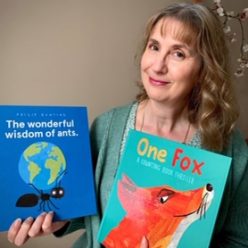Illustrated by Satoshi Kitamura

Published by Walker Books, London, 2019
There is no time like now to be more aware of the importance of biodiversity in our world. All living things, from the tiniest plankton to the mighty blue whale, belong to an interconnected web of life, intricate in its complexity and vital to the health of our planet. Ugly or beautiful, scary or cute, gentle or terrifying, the creatures that live in our natural world deserve to be understood and protected.
Martin Jenkins is a conservation biologist, and he has written picture books which help young readers to understand the behaviours and habitats of some of our most endangered species.
Beware of the Crocodile starts like a conversation, “The main thing about crocodiles is they’re really scary – or least the big ones are. They’ve got an awful lot of teeth.” Jenkins goes on to describe the eating habits of crocodiles, the habitats they live in and how long it takes for them to mature. Surprisingly, female crocodiles are exceptionally good mothers, guarding newly hatched babies for many weeks from predators and other crocodiles.
There is more information about crocodiles at the end of the book and a description of the differences between alligators, caimans and crocodiles. There are web addresses to go to for more information and an index of important words in the text for older readers.
Other picture books by Martin Jenkins include Ape, The Emperor’s Egg, Can We Save the Tiger and Fabulous Frog. This is one of my favourite quotes by him:
When it comes to looking after all the species that are already endangered, there’s such a lot to do that sometimes it might all seem to be too much, especially when there are so many other important things to worry about. But if we stop trying, the chances are that pretty soon we’ll end up with a world where there are no tigers or elephants, or sawfishes or whooping cranes, or albatrosses or ground iguanas. And I think that would be a shame, don’t you? (Can We Save The Tiger?, 2011)
I can highly recommend this picture book for children 2-8 years and below are more suggestions for books that focus on crocodiles, mostly fictional and not so much fact!



by Bonny Becker
Illustrated by David Small

by Judith Kerr

by Catherine Rayner

by Catherine Rayner

by Kim Kane
Illustrated by Sara Acton

by Paul Galdone


by Allan Ahlberg
Illustrated by Bruce Ingman



by Alison Lester

by Bernard Waber

by Martin Hughes
Illustrated by children from the Familia Hope Orphanage












